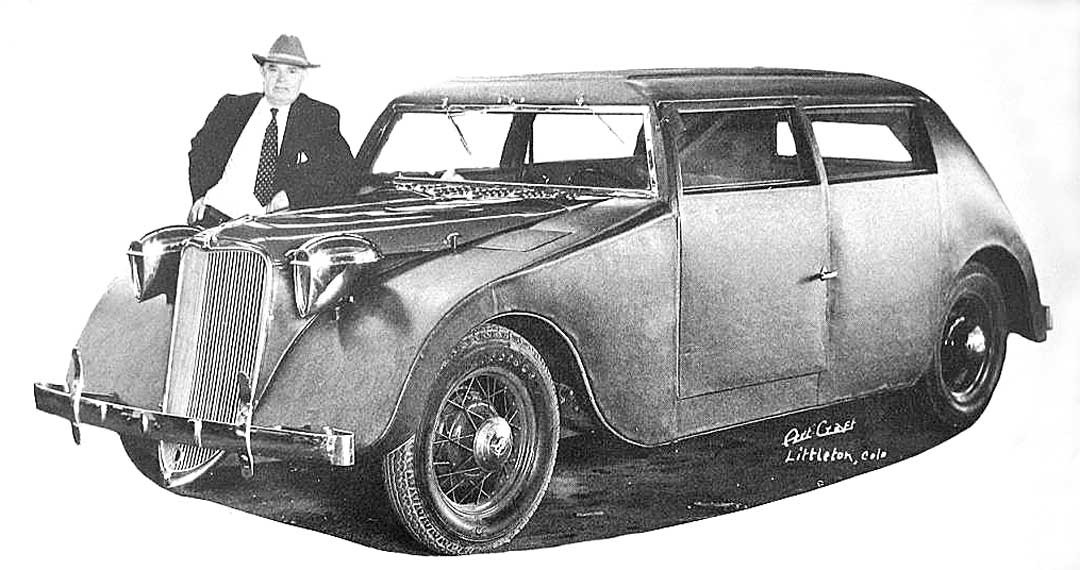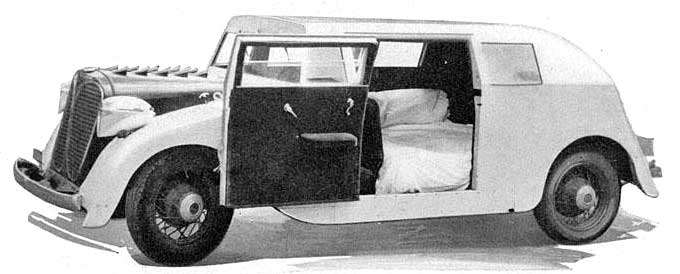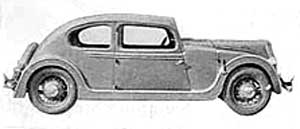Harleigh R. Holmes was a natural-born inventor who formed the Holmes Motor Co. in the late teens and built a four-wheel-drive truck by 1920. Soon after arranging financing and the support of the Plains Iron Works of Denver in 1921. At that point Holmes designed a successful four-wheel-drive conversion kit for the Model “T” Ford.
Lead photo – 1935 Coleman “Custom” equipped a front-mounted Ford 85 h.p. V-8 engine, transmission, rear axles and wheels.
In 1922 wealthy miners Alfred E. Coleman and his brother George, who had made a fortune in lead, zinc, and silver, bought a controlling interest in the Plains Iron Works and moved it back to Littleton, where it originated. The firm was eventually renamed the Coleman Motor Company and built heavy-duty four-wheel-drive trucks until the late-1920s. George Coleman assumed control of the Company when Alfred died in 1930.
- 1932 front-wheel-drive “Maroon Car” powered by a rear-mounted Pontiac V-8.
In the late-1920s, Holmes designed and built the first of five low to the ground experimental cars, the “Blue Goose” with a slab-sided full-width body for the Coleman Motor Co. The front-wheel-drive vehicle was powered by a Model “A” Ford engine set transversely in front of the axle. The “Maroon Car” above followed in 1932. It was powered by rear-mounted Pontiac V-8.
- 1932 “White Car” featured a front-mounted Ford V-8 and rear wheel drive with an arched front axle.
The “Maroon Car” was quickly followed in 1932 by the rear-wheel-drive “White Car” pictured above and below powered by the new Ford V-8 engine, and may have utilized some Ford chassis components. It was the first of the cars that used Holmes’ new patented arched front axle design that passed over the top of the engine.
- The “White Car” with room for a full width bed – November 1933 issue of Popular Science.
- The White Car was used as the basis for the 1934 Brown Car with some new design ideas and has been reported to have used more conventional styling. This illustration may contain that vehicle.
The last of the five cars, the 1935 “Custom,” is shown in the lead photo. This model was equipped with a front-mounted Ford 85 h.p. V-8, transmission, rear axles, and wheels. This model used the same patented chassis design below as the “White” and “Brown” cars with slightly smoother styling finished off with a Ford grille and the distinctive Woodlite headlamps that the earlier cars used.
All of Holmes’ designs were engineering studies, and the appearance of them was secondary. Coleman continued to finance their construction for testing and patent development, apparently planed to manufacture chassis components for other automakers in the future. The “White Car” predated the Chrysler Airflow and the Stout Scarab and may have somehow helped influence the styling of both.
Coleman later merged with the Howe Brothers and manufactured and sold front-wheel-drive axles for trucks as late as the 1990s.
Photos and some background information are courtesy of the City of Littleton and Paul Juray at AutoPuzzles.
- Harleigh Holmes 1932 patent application drawings for the arched axle design, granted on May 2, 1932.









Great article.
Wonder why the last model “Custom” didn’t follow the earlier models having color names?
The Woodlite headlamps help with identifying the models.
Has there been a production car with an RF layout like the Maroon? It seems like a very odd layout, although for an engineering testbed intended to generate patents it makes more sense.
For the merger history – Coleman and American Road Equipment merged in 1948, becoming American-Coleman. In 1968, the company was acquired by Kansas City Southern Industries, a division of the Kansas City Southern Railroad. KCSI spun off all its non-rail businesses in the early 2000s, and I’m not sure where the Coleman assets went at that point. Howe Brothers was a licensed Coleman distributor from 1929-1950, when the arrangement was revoked for using unauthorized parts. Howe then developed their Howe-Coleman axle, which was sold until the mid-90s, as a knock-off of the Coleman axle.
Brutalist Architecture of the ‘60’s has nothin’ on these Coleman Cars that bring to mind a Tesla Cybertruck and Cadillac’s Plywood School of Auto Design from recent years. Per Wiki, it’s interesting that the “Maroon Car” used Pontiac’s one-year-only 251 cu in oversquare V-8 of 1932
I find out how much I don’t know reading Old Motor articles about these kinds of near one-off vehicles. Not only had I not ever heard of a Coleman Car, I also didn’t know Pontiac ever made a V8 prior to 1955. Straight eight yes, V8 no. I was even thinking about posting the question, “You mean a straight eight?” But I at least had sense enough to read the comments first. Thanks Pat.
The 1932 Pontiac V8 was a continuation of the 135 degree engine that powered the 1930-’31 Oaklands. Although it had other design flaws, it and the Viking V8 engines were mono-block construction before the 1932 Ford flathead V8.
What is the perceived advantage of arching the axle over the motor? Lower overall profile? It seems like he’s going about it the hard way.
Lowering the center of mass to help with stability. On the trucks, Coleman also avoided the obvious problem of access to the engine by placing it on a roll-out bed, so the entire thing would slide out from under the axle.
Given the lowness of the car, there seems no room for it to be below the engine without it dragging on the ground. (And going around the front is right out.) At the same time tho, it does look like the steering linkage does pass below the engine. Fig.2 does little to show how the steering was actually hooked up. Comparing Fig.1 and Fig.2 it looks like the unusual forward placement of the engine situated the gearshift a good foot in front of the steering wheel to the point the driver would have had to lean well forward to manipulate it, probably not a desirable trait. I suspect the drawings for the car are some not-fully-thought-out preliminary design ideas and compromises were made along the way to building the vehicle.
Now there’s another fine article continuing with my learning something new every day, an arched axle idea just blew my mind. Just amazing. The cars don’t look too bad style wise except for White car with it’s dark nose. A little low but still interesting looks.
I drove through Littleton in June. Didn’t see any of these. Quite interesting design, at least he was thinking.
The Granddaddy of the Hummer
These look like homebuilt armored cars.
Echoes of Voisin
Is this the same Holmes that built the aircooled Holmes in the mid-Twenties?